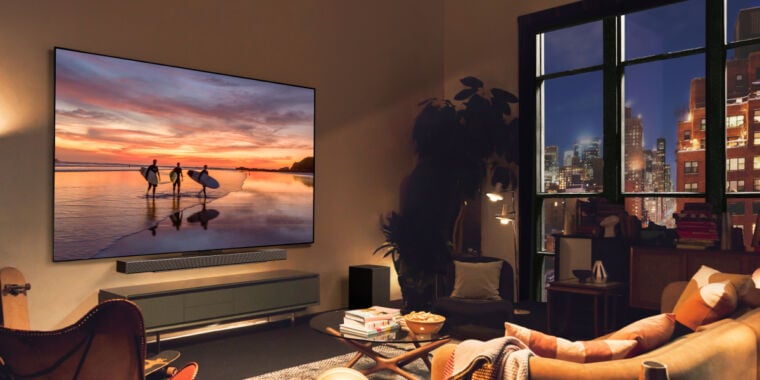The move embodies how ads are a growing and virtually inescapable part of the TV-viewing experience—even when you’re not watching anything.
As you might have expected, LG didn’t make a big, splashy announcement to consumers or LG TV owners about this new ad format. Instead, and ostensibly strategically, the September 5 announcement was made to advertisers. LG appears to know that screensaver ads aren’t a feature that excites users. Still, it and many other TV makers are happy to shove ads into the software of already-purchased devices.
LG TV owners may have already spotted the ads or learned about them via FlatpanelsHD, which today reported seeing a full-screen ad on the screensaver for LG’s latest flagship TV, the G4. “The ad appeared before the conventional screensaver kicks in," per the website, “and was localized to the region the TV was set to.”
LG has put these ads on by default, according to FlatpanelsHD, but you can disable them in the TVs’ settings. Still, the introduction of ads during a screensaver, shown during a pause in TV viewing that some TVs use as an opportunity to show art or personal photos that amplify the space, illustrates the high priority that ad dollars and tracking have among today’s TVs—even new top-of-the-line ones.
The addition of screensaver ads that users can disable may sound like a comparatively smaller disruption as far as TV operating system (OS) ads go. But the incorporation of new ad formats into TV OSes’ various nooks and crannies is a slippery slope. Some TV brands are even centered more on ads than selling hardware. Unfortunately, it’s up to OS operators and TV OEMs to decide where the line is, including for already-purchased TVs. User and advertiser interests don’t always align, making TV streaming platforms without third-party ads, such as Apple TV, increasingly scarce gems.



Disconnect your TV from internet. They are slow & limited, have ads and a lot of data harvesting.
Get an Android device that faster and give you more control (not firestick etc.)
As if android tv isn’t also loaded to hell with ads and reliant on streaming networks that basically all have increasingly obtrusive ads
Either only buy physical or pirate all of your media, set up a jellyfin server, set up a dns server that blocks ads (adguard, pihole) and point any device that can connect to the internet at it. Cancel all of your streaming subscriptions and use a coreelec box to watch your media from your jellyfin server. There are literally no other ways to not get obtrusive advertising.
If you have an lg webos tv like me you can keep it connected to the internet but root it, block updates in homebrew channel, install YouTube with adblocking and sponsor block, and then again make sure it’s getting dns from your ad block server. Add in custom rules for
us.ad.lgsmartad.com us.info.lgsmartad.com ngfts.lge.com lgad.cjpowercast.com edgesuite.net us.rdx2.lgtvsdp.com us.info.lgsmartad.com us.ibs.lgappstv.com us.lgtvsdp.com ad.lgappstv.com smartshare.lgtvsdp.com ibis.lgappstv.com us.ad.lgsmartad.com lgad.cjpowercast.com.edgesuite.net ngfts.lge.com yumenetworks.com smartclip.net smartclip.com
snu.lge.com su.lge.com lgtvonline.lge.com
These block ads and the last three block the update servers. The update blocking isn’t strictly necessary if you have rooted and blocked updates in homebrew channel but it will get rid of the annoying “new version” nag that pops up when you turn on the tv. You may have to clear caches on the tv
Any tips for a newbee where to start looking for learning to root a TV?
What kind of tv? For webos it’s potentially a bit complicated but also potentially stupid easy depending on which version of webos your tv has
https://www.webosbrew.org/rooting/
I would strongly suggest avoiding nvm even if it’s supported unless you’re very comfortable with hardware hacks. The others are all software and fairly easy to do if you’re capable with following instructions. The most recent, dejavuln, is fairly simple but can be a bit finicky (you may have to try a bunch of times) but lg is also rolling out patches for it so if your tv is updated you may be out of luck. It’s hard to say because the patches aren’t rolled out unilaterally. Webos is a bit confusing and there are many “branches” that all have similar features but wildly different numbering. If your tv is patched block updates by either disconnecting from the internet or blocking the above sites in your router and watch the webos homebrew discord (linked on that site). There are people actively researching new exploits and if one pops up it’ll be discussed in the discord first (and if it’s a big deal, like they expect it to be patched, they usually ping everyone to let them know to do it asap)
Bingo. Shield pro, and blacklist the MAC address of the TV and NEVER update the firmware.
…bacause that would add ads. I hate this whole ecosystem.
The regular shield does just fine for me, I can attach hard drives to my router and mount them as smb shares, and then access movies with VLC Player.
What kind of router do you use? That setup has never worked for me with Asus routers for more than few days.
ASUS RT-AX88U with Merlin firmware. Running stable since 2019 or so.
Edit: https://www.asuswrt-merlin.net/
Interesting. That is very close to the setup I’m using. Maybe I’ll give it another try.
deleted by creator